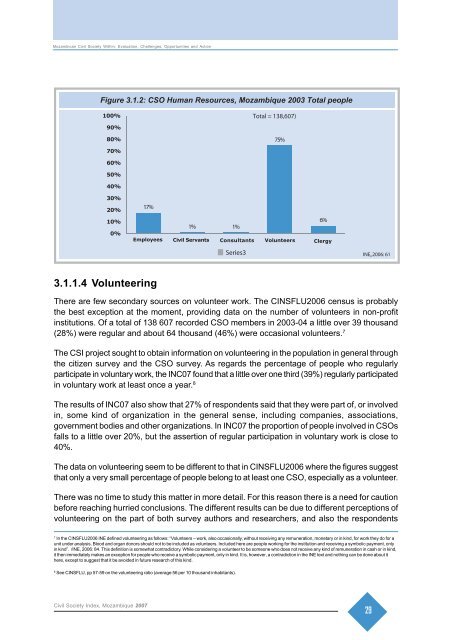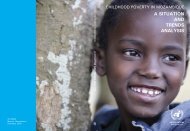Mozambican Civil Society Within: - UNICEF Mozambique - Home page
Mozambican Civil Society Within: - UNICEF Mozambique - Home page
Mozambican Civil Society Within: - UNICEF Mozambique - Home page
You also want an ePaper? Increase the reach of your titles
YUMPU automatically turns print PDFs into web optimized ePapers that Google loves.
<strong>Mozambican</strong> <strong>Civil</strong> <strong>Society</strong> <strong>Within</strong>: Evaluation, Challenges, Opportunities and Action<br />
Figure 3.1.2: CSO Human Resources, <strong>Mozambique</strong> 2003 Total people<br />
100%<br />
90%<br />
80%<br />
Total = 138,607)<br />
75%<br />
70%<br />
60%<br />
50%<br />
40%<br />
30%<br />
20%<br />
10%<br />
0%<br />
17%<br />
6%<br />
1% 1%<br />
Employees <strong>Civil</strong> Servants Consultants Volunteers Clergy<br />
Series3<br />
INE,,2006: 61<br />
3.1.1.4 Volunteering<br />
There are few secondary sources on volunteer work. The CINSFLU2006 census is probably<br />
the best exception at the moment, providing data on the number of volunteers in non-profit<br />
institutions. Of a total of 138 607 recorded CSO members in 2003-04 a little over 39 thousand<br />
(28%) were regular and about 64 thousand (46%) were occasional volunteers. 7<br />
The CSI project sought to obtain information on volunteering in the population in general through<br />
the citizen survey and the CSO survey. As regards the percentage of people who regularly<br />
participate in voluntary work, the INC07 found that a little over one third (39%) regularly participated<br />
in voluntary work at least once a year. 8<br />
The results of INC07 also show that 27% of respondents said that they were part of, or involved<br />
in, some kind of organization in the general sense, including companies, associations,<br />
government bodies and other organizations. In INC07 the proportion of people involved in CSOs<br />
falls to a little over 20%, but the assertion of regular participation in voluntary work is close to<br />
40%.<br />
The data on volunteering seem to be different to that in CINSFLU2006 where the figures suggest<br />
that only a very small percentage of people belong to at least one CSO, especially as a volunteer.<br />
There was no time to study this matter in more detail. For this reason there is a need for caution<br />
before reaching hurried conclusions. The different results can be due to different perceptions of<br />
volunteering on the part of both survey authors and researchers, and also the respondents<br />
7<br />
In the CINSFLU2006 INE defined volunteering as follows: “Volunteers – work, also occasionally, without receiving any remuneration, monetary or in kind, for work they do for a<br />
unit under analysis. Blood and organ donors should not to be included as volunteers. Included here are people working for the institution and receiving a symbolic payment, only<br />
in kind”. /INE, 2006: 84. This definition is somewhat contradictory. While considering a volunteer to be someone who does not receive any kind of remuneration in cash or in kind,<br />
it then immediately makes an exception for people who receive a symbolic payment, only in kind. It is, however, a contradiction in the INE text and nothing can be done about it<br />
here, except to suggest that it be avoided in future research of this kind.<br />
8<br />
See CINSFLU, pp 57-59 on the volunteering ratio (average 56 per 10 thousand inhabitants).<br />
<strong>Civil</strong> <strong>Society</strong> Index, <strong>Mozambique</strong> 2007<br />
29
















